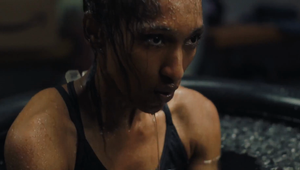
Behind Ellie Goulding’s Poignant Latest Music Video

Ellie Goulding’s new music video for ‘Like A Saviour’ features an endless desert, some truly magical choreography, and incredible day and night sky scenes. All of this was achieved through the help of 360 VP screens on set, and was shot in just a day, directed by Rogue’s Joe Connor. The single will be part of Goulding’s upcoming fifth studio album, ‘Higher Than Heaven’, to be released on March 24th, 2023.
The music video is an exercise in excellent usage of VP screens, and can easily serve as a prime example of how the industry can use them to their fullest potential - across all sectors. Joe explains that although it comes with all challenges of new tech, such as being able to force depth and interacting with the sand on set (it is a desert at the end of the day), working with the screens gave the production the ability to literally travel through time.
‘Like A Saviour’ also sees collective (LA)HORDE performing an unforgettable choreography by Daniel Alwell that not only matches the environment of the video perfectly, but executes the director’s crazy vision of ‘worms coming out of the soil’.
LBB’s Zoe Antonov caught up with Joe on his experience using VP screens, putting together art and technology and some fun challenges on set.
LBB> Joe, tell me more about the initial ideas that you had for the music video and those developed. What did you know about Ellie’s vision, and how did it come together with your own?
Joe> Ellie presented me with a brave and exciting brief. She’s going through a really exciting renaissance period in her own work, embracing art, styling, and image-making. She’s got a great team around her, so I felt that the time was right to pitch something bold - combining art and technology. I had this idea of Ellie in an endless desert landscape that shifted and changed.
Working closely with my team, Fred Bonham Carter and Alexa Haywood, we envisioned a desert where time moves quickly. Fred is brilliant at straddling creative and production, finding ways to execute my ideas. He brought DNEG (VFX, computer animation and stereo conversion studio) on board as partners, and together with David Procter, we had a great core of experts to pull this off.
This technology is so new - particularly in music videos - that we had to build many of the process workflows and systems from scratch.
LBB> Why did you decide to go with the desert as your main setting?
Joe> There is something about these simple, elemental locations that resonates with me. I love working with them - they feel like timeless and endless spaces of beauty. This type of landscape also works well with virtual production; it helps to create a seamless blend with the real world. There is one issue though - sand does not play nicely with raw LED screens, as we discovered.
LBB> The usage of shapes in the video is striking. Was that a goal from the very beginning and why did you think it is a good approach to take?
Joe> Although the video was filmed in a simple desert location, I aimed to incorporate variety, such as big sloping sand dunes and vast expanses, to give the film more scale and scope. I also wanted the choreography to convey this same feeling, so I collaborated with Daniel Alwel from La Horde to choreograph it, and I think he did a brilliant job.
LBB> How did you work with choreography to execute your vision and how important was it to bring everything together?
Joe> My initial idea was to portray human bodies as worms, emerging from the sand and stretching up to the sky. Daniel took this seemingly insane starting point and transformed it into a brilliant movement. The choreography he created is a great blend of storytelling and shapes. I could watch those guys move all day.
LBB> Tell me more about the usage of colour to set the tone throughout the video - how did the colours interplay with each other, especially with all the contrasting cool and warm tones?
Joe> I wanted the time of day to constantly shift from day to night and back again. Our goal was to create a rich colour palette, so David and the DNEG team spent a lot of time morphing between lighting states. It's challenging to get warmth and tonal depth from VP screens. We wanted to push the colour variety in the sky, as well as the intensity and luminosity of the light. The trick to making it feel real was to try and engineer the real world lighting to have the right halation, saturation and soft directional light, and to try and not wash out the screens at the same time. There was a lot of research and development that went into creating this look. David did a fantastic job creating a unique palette, and George K at Blackkite added the finishing touches to achieve a really cool look.
LBB> Tell me more about the usage of the 360 screens throughout the video - why did you decide to use them, what were the benefits of using them and what were the biggest challenges?
Joe> I really felt that this was the perfect opportunity to engage with this tech. The great benefits are obviously that you can totally design and build a 3D world, set the light path, set the moon path, set the stars, the intensity of light, the weather, everything. We had AI clouds moving across our world which was a wild and unique quirk. The creative freedom is unparalleled, but it really needs quite strict parameters and a robust HOD team to turn that ‘anything’ into something. Just like anything, it’s a tool to be used.
The joy was setting the perfect lighting, sky and weather that could then last 12 or 13 hours. The biggest challenge is the process and the communication structure needed to work with the screens, in so much as it’s almost like a live animal on stage. The screens take a lot of render power and human coding to create the incredible effect, and that means that working on them can be a complicated affair. But, with the right team, like we had, you get great results.
LBB> How was the tilt in the set achieved on the scenes where the dancers are climbing a hill? Or was it really good camera work and acting on a regular non-tilted floor?
Joe> That was a really funny one. One of the main negatives of working in VP is getting scale. It seems obvious, but it’s hard to get physical distance from the screens, so I wanted a second environment in the video that would force perspective.
The trick was an old school trick, repurposed using new technology. I simply dutched the camera and dutched the background on the screens. Because everything that was built in Unreal Engine, I could also increase the height on the background. As a result, it felt like we were miles above the dunes to create this effect of being on a huge dune. The dancers then had to perform across this flat piece of set as though they were scaling a huge mountain.
LBB> How long did the filming process take with the usage of the 360 screens? And would you use them more in the future for other music videos?
Joe> We had a one day shoot, which is always tricky with this kind of project, but we had a lot of research and development, set builds, pre lights and test days with DNEG and the team. Fred did a great job of managing the whole project to make sure that we could get the most out of the screens. I would use them again and I'd love to push the technology further, which really speaks to my theatre background. I’m sure there are bigger ideas, bolder worlds and more bonkers uses of these screens, and I'd love to explore them.
LBB> What were the most fun parts in making the video? And the most challenging?
Joe> I think the fun was in seeing the effect with your own eye in the space. VFX is a great tool, but the beauty of VP screens is that you can be immersed in the world yourself, while you are there. That helps performers, crew, lighting, art… Everything benefits from seeing the atmosphere of the world on the screen. There was also a lot of joy in seeing the tilted section working.
The most challenging...music videos are always challenging, that's why we love them.












